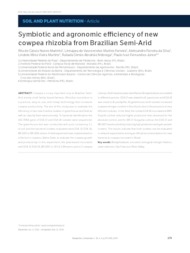Symbiotic and agronomic efficiency of new cowpea rhizobia from Brazilian Semi-Arid.
Symbiotic and agronomic efficiency of new cowpea rhizobia from Brazilian Semi-Arid.
Author(s): MARINHO, R. de C. N.; FERREIRA, L. de V. M.; SILVA, A. F. da; MARTINS, L. M. V.; NÓBREGA, R. S. A.; FERNANDES JUNIOR, P. I.
Summary: Cowpea is a very important crop to Brazilian Semi-Arid mainly small family-based farmers. Rhizobia inoculation is a practice, easy to use, and cheap technology that increases cowpea productivity. The aim of this study was to evaluate the efficiency of two new rhizobia isolates in greenhouse and field as well as classify them taxonomically. To bacterial identification the 16S rRNA gene of ESA 17 and ESA 18 isolates were sequenced. The greenhouse test was conducted with pots containing 3 L of soil and the bacterial isolates evaluated were ESA 17, ESA 18,BR 3267 or BR 3262 strains. A field experiment was implemented on a Vertisol in Juazeiro, Bahia State, to evaluate the cowpea growth and productivity. In this experiment, the peat-based inoculants with ESA 17, ESA 18, BR 3267 or UFLA 3-84 were used in 2 cowpea cultivars. Both bacteria were identified as Bradyrhizobium, but related to different species. ESA 17 was related to B. japonicumand ESA 18 was closer to B. pachyrhizi. At greenhouse, both isolates increased cowpea nitrogen content in the shoots due to the presence of very efficient nodules. In the field, the isolate ESA 18 inoculated at BRS Pujante cultivar induced higher production than observed for the absolute control, and for BR 17 Gurguéia cultivar, he ESA 17 and BR 3267 stood out both by inducing high production and grain protein content. The results indicate that both isolates can be evaluated in network experiments aiming at official recommendation for new bacteria to cowpea inoculant in Brazil.
Publication year: 2017
Types of publication: Journal article
Unit: Embrapa Semi-arid Region
Observation
Some of Embrapa's publications are published as ePub files. To read them, use or download one of the following free software options to your computer or mobile device. Android: Google Play Books; IOS: iBooks; Windows and Linux: Calibre.
Access other publications
Access the Agricultural Research Database (BDPA) to consult Embrapa's full library collection and records.
Visit Embrapa Bookstore to purchase books and other publications sold by Embrapa.

